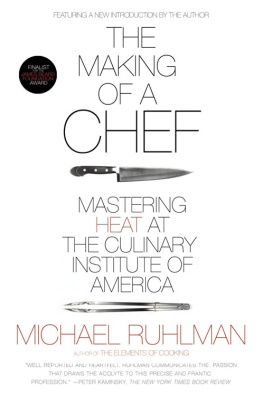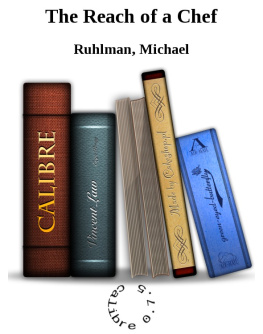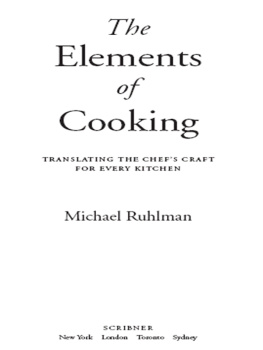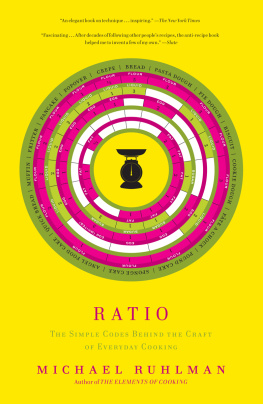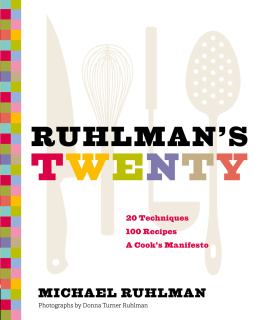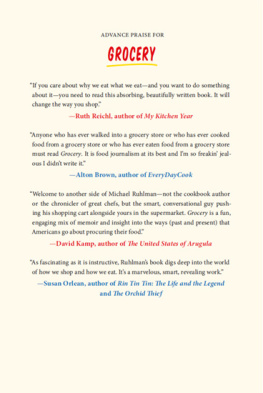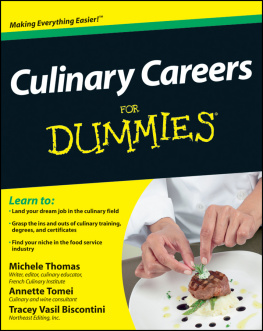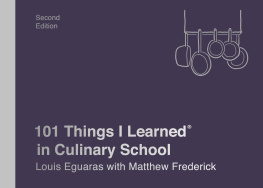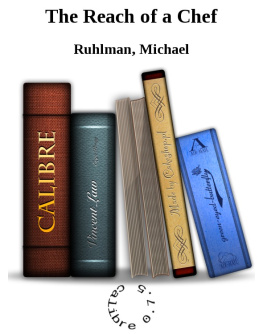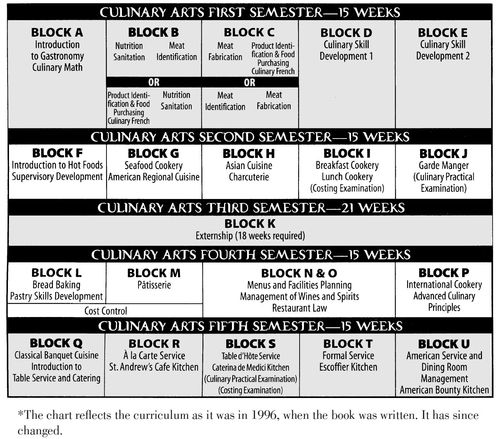First, my thanks to Ferdinand Metz and Tim Ryan for allowing me into the Culinary Institute of America. I do not remember a single significant request that was turned down. Dr. Fred Mayo was generous with his time and offered valuable guidance through the labyrinthine institute. Andrea Harding likewise worked hard on my behalf, as did Janis Wertz. All chef-instructors were generous with their time in answering my questions; many, however, such as Todd Philbrook (sorry about the show plate!) and Tom Griffiths, do not appear in this narrative though I owe much to them. Of the many reference books I used, the most valuable was the Culinarys own, The New Professional Chef; as far as basic cooking methods and standard ratios, I know of no better cookbook. Finally I am grateful to all the chefs and students who appear in this book for their time and their willingness to be a part of this story.
I would like to thank my agent, Elizabeth Kaplan, to whom I am permanently indebted.
No one can know how judicious and intelligent Bill Strachan, my editor, has been in his work because his effect is so subtle as to be invisible and yet he improved the manuscript enormously. I am grateful to him.
Thanks forever to R.P.
I would like to thank my mother, Carole, who, besides being an awesome mom, is the personification of human generosity and high spirits.
Words do not exist to adequately thank my wife and daughter, as the reader will soon appreciate. They are to me the most miraculous duo on earth, and I would be lost without them.
MICHAEL RUHLMAN is the author of twelve books, including The Elements of Cooking and The French Laundry Cookbook . He lives in Cleveland with his wife, daughter, and son and is a frequent contributor to The New York Times and Gourmet as well as his highly popular blog at www.Ruhlman.com .
Benediction
T he first Saturday cooking at Bounty, the day Id begun cooking for real and my partner John had told Gene hed never have known I was a writer, I drove out to Chef Parduss house. In one respect, it was sort of a pilgrimage. He was the reason I was able to hold my own in Bounty, the reason I passed the practical exam, the reason I could move through any kitchen now with confidence. He had been a good teacher. I once asked Chef Turgeon who his Skills teacher had been. He named her and said, You go through a lot of classes here, but you never forget your Skills teacher. This was true. Also, I missed Chef Pardus, missed hearing him talk about food, missed arguing about whether the hollandaise had too much acid or not enough salt.
When I called for directionsmy pretext for meeting him, though I hardly needed one, was to find out how his three weeks in Brazil had gonehe said, I live in the wilderness. He said his nearest neighbors were the kinds of folks who put broken washing machines on their front lawn. Behind his rented ranch-style house, cornfields extended for miles, it seemed, and beyond them were the Catskill Mountains, a hazy blue when I arrived on that warm bright summer afternoon. His dogs Pumpkin and Early yapped and danced as Pardus welcomed me and led me to his kitchen. He was dressed in jean shorts, newly cut off and without fray. He had been crushing ice.
I was just about to make myself a mint julep, he said. Care to join me? I said I would very much care to. Ive got mint growing in the backyard, hesaid, noting that juleps were the very best possible use of mint he knew of. I was inclined to agree, especially on such a fine warm late afternoon as this.
We sat on a small patio in his backyard and chatted, drinking from our enormous glasses perfect examples of the mint julep, and the sun hovered over the Catskills. He told me about Brazil and how the wheat there was different, and therefore sauce making was different because the roux was different. He went through the logic, returning me instantly to Skills class. Where is our wheat grown? he asked me. What are the characteristics of that wheat? The harsher the climate, Id learned from Chef Coppedge, the stronger the wheat; the thing that made wheat strong was protein. Wheat grown in the harsh weather of the Great Plains was very high in protein. Where is theirs grown? Pardus continued in his manic way. So that means what? Theirs is going to be low in protein, low in gluten, and high starch . So to make a roux you need more of everything and you can cook sauces forever without getting the starchy taste and feel out. Because of their geography, his students in Brazil used pure starch, such as arrowroot, to thicken sauces. Arrowroot grows down there, Pardus told me. You can buy it fresh in the market.
He showed me pictures of the friends hed made, pictures of the kitchen and his students.
Then we sat back and relaxed. What a fine evening to be drinking a gigantic mint julep, I thought, after a long day cooking, and now surrounded by a sea of corn, hazy and almost glowing, backlit by the sun descending over the mountains, the dogs dashing in and out between the stalks and romping throughout the herb garden. A small fig tree, a gift from Chef Griffiths, grew in a pot beside the garden. We were shaded by a young beechnut tree. It was a perfect summer evening, and, recalling the blizzards of winter, it was an apt time to say what I had wanted to for some time.
Chef, I want to thank you, I said. I know Im a writer and not a cookI was always careful to make this distinction, especially around Pardusbut I wouldnt be able to do what Im doing had I not started in your Skills class.
Hey, Michael, he said. Youre a cook. If youre working the grill station in American Bounty on a Saturday afternoon, youre a cook.
I felt a powerful surge of emotion. My God, I was a cook. This had been something that Id wanted to achieve, to be , since that winter storm. John had given me a great compliment that afternoon, but now the name had been bestowed on me by the only person who could rightfully do it, my Skills teacher. I was enormously, irrationally proud. Proud to be a cook.
T he bundle waiting for me on the couch had been secured with butchers string and looked as ordinary as laundry. I tucked it beneath my arm and strode out of the office and through Roth Hall, the main building of the Culinary Institute of America, slipped into a bathroom, and closed myself off in the farthest stall. I removed my sweater and jeans and stuffed them into my leather shoulder briefcase. I untied the bundle, shook out one of two pairs of houndstooth-check trousers, and stepped into them, then buttoned the immaculately white, double-breasted chefs jacket over my white T-shirt. I jammed the extra set of pants into the briefcase along with my street clothes, snapped it shut, grabbed my black overcoat and knife kit, and pushed out of the stall.
I stopped at the mirror. I had not been in a uniform since high school football and I sent myself an ironic lift of the eyebrows, then an uncertain shrug. The figure in the mirrordressed as a culinary studentlooked like me and did not. The figure seemed more a secret sharer. I could not dwell long on this uniformed other selfI had only a few minutes to find K-8, the Skills kitchen run by Chef Michael Pardus.

